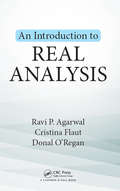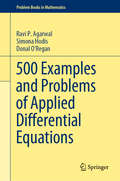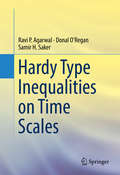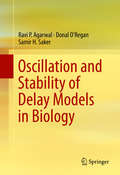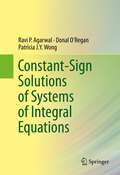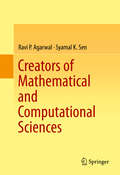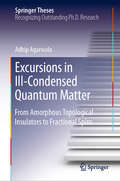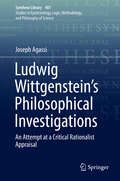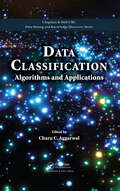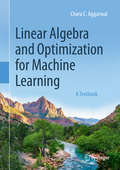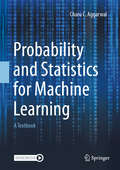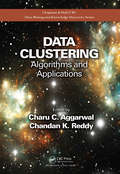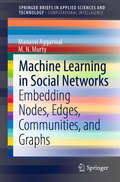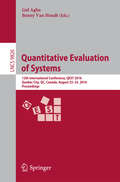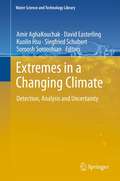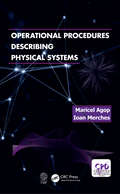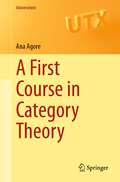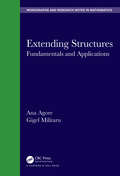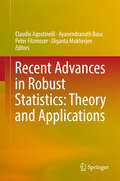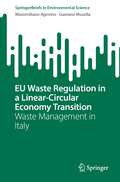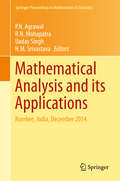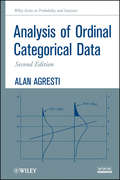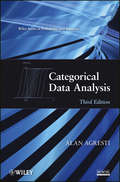- Table View
- List View
An Introduction to Real Analysis
by Ravi P. Agarwal Donal O'Regan Cristina FlautThis book provides a compact, but thorough, introduction to the subject of Real Analysis. It is intended for a senior undergraduate and for a beginning graduate one-semester course.
500 Examples and Problems of Applied Differential Equations (Problem Books in Mathematics)
by Ravi P. Agarwal Donal O’Regan Simona HodisThis book highlights an unprecedented number of real-life applications of differential equations together with the underlying theory and techniques. The problems and examples presented here touch on key topics in the discipline, including first order (linear and nonlinear) differential equations, second (and higher) order differential equations, first order differential systems, the Runge–Kutta method, and nonlinear boundary value problems. Applications include growth of bacterial colonies, commodity prices, suspension bridges, spreading rumors, modeling the shape of a tsunami, planetary motion, quantum mechanics, circulation of blood in blood vessels, price-demand-supply relations, predator-prey relations, and many more.Upper undergraduate and graduate students in Mathematics, Physics and Engineering will find this volume particularly useful, both for independent study and as supplementary reading. While many problems can be solved at the undergraduate level, a number of challenging real-life applications have also been included as a way to motivate further research in this vast and fascinating field.
Hardy Type Inequalities on Time Scales
by Ravi P. Agarwal Donal O'Regan Samir H. SakerThe book is devoted to dynamic inequalities of Hardy type and extensions and generalizations via convexity on a time scale T. In particular, the book contains the time scale versions of classical Hardy type inequalities, Hardy and Littlewood type inequalities, Hardy-Knopp type inequalities via convexity, Copson type inequalities, Copson-Beesack type inequalities, Liendeler type inequalities, Levinson type inequalities and Pachpatte type inequalities, Bennett type inequalities, Chan type inequalities, and Hardy type inequalities with two different weight functions. These dynamic inequalities contain the classical continuous and discrete inequalities as special cases when T = R and T = N and can be extended to different types of inequalities on different time scales such as T = hN, h > 0, T = qN for q > 1, etc. In this book the authors followed the history and development of these inequalities. Each section in self-contained and one can see the relationship between the time scale versions of the inequalities and the classical ones. To the best of the authors' knowledge this is the first book devoted to Hardy-type inequalities and their extensions on time scales.
Oscillation and Stability of Delay Models in Biology
by Ravi P. Agarwal Donal O'Regan Samir H. SakerEnvironmental variation plays an important role in many biological and ecological dynamical systems. This monograph focuses on the study of oscillation and the stability of delay models occurring in biology. The book presents recent research results on the qualitative behavior of mathematical models under different physical and environmental conditions, covering dynamics including the distribution and consumption of food. Researchers in the fields of mathematical modeling, mathematical biology, and population dynamics will be particularly interested in this material.
Constant-Sign Solutions of Systems of Integral Equations
by Ravi P. Agarwal Donal O'Regan Patricia J. Y. WongThis monograph provides a complete and self-contained account of the theory, methods, and applications of constant-sign solutions of integral equations. In particular, the focus is on different systems of Volterra and Fredholm equations. The presentation is systematic and the material is broken down into several concise chapters. An introductory chapter covers the basic preliminaries. Throughout the book many examples are included to illustrate the theory. The book contains a wealth of results that are both deep and interesting. This unique book will be welcomed by mathematicians working on integral equations, spectral theory, and on applications of fixed point theory and boundary value problems.
Creators of Mathematical and Computational Sciences
by Ravi P Agarwal Syamal K SenThe book records the essential discoveries of mathematical and computational scientists in chronological order, following the birth of ideas on the basis of prior ideas ad infinitum. The authors document the winding path of mathematical scholarship throughout history, and most importantly, the thought process of each individual that resulted in the mastery of their subject. The book implicitly addresses the nature and character of every scientist as one tries to understand their visible actions in both adverse and congenial environments. The authors hope that this will enable the reader to understand their mode of thinking, and perhaps even to emulate their virtues in life.
Excursions in Ill-Condensed Quantum Matter: From Amorphous Topological Insulators to Fractional Spins (Springer Theses)
by Adhip AgarwalaImpurities, disorder or amorphous systems – ill-condensed matter – are mostly considered inconveniences in the study of materials, which is otherwise heavily based on idealized perfect crystals. The Kondo effect and the scaling theory of localization are among the fundamental and early discoveries which revealed the novelty hidden in impure or disordered systems. Recent advances in condensed matter physics have emphasized the role of topology, spin-orbit coupling, and certain discrete symmetries such as time reversal in many physical phenomena. These have irreversibly transformed the essential ideas and purview of condensed matter physics, both in theoretical and experimental directions. However, many of these recent developments and their implications are limited to, or by, ideas that pertain to clean systems. This thesis deals with various aspects of these new developments, but in the case of unclean systems. The author introduces new ideas such as amorphous topological insulators, fractalized metals and fractionalized spins.
Ludwig Wittgenstein’s Philosophical Investigations: An Attempt at a Critical Rationalist Appraisal (Synthese Library #401)
by Joseph AgassiThis book collects 13 papers that explore Wittgenstein's philosophy throughout the different stages of his career. The author writes from the viewpoint of critical rationalism. The tone of his analysis is friendly and appreciative yet critical. Of these papers, seven are on the background to the philosophy of Wittgenstein. Five papers examine different aspects of it: one on the philosophy of young Wittgenstein, one on his transitional period, and the final three on the philosophy of mature Wittgenstein, chiefly his Philosophical Investigations. The last of these papers, which serves as the concluding chapter, concerns the analytical school of philosophy that grew chiefly under its influence. Wittgenstein’s posthumous Philosophical Investigations ignores formal languages while retaining the view of metaphysics as meaningless -- declaring that all languages are metaphysics-free. It was very popular in the middle of the twentieth century. Now it is passé. Wittgenstein had hoped to dissolve all philosophical disputes, yet he generated a new kind of dispute. His claim to have improved the philosophy of life is awkward just because he prevented philosophical discussion from the ability to achieve that: he cut the branch on which he was sitting. This, according to the author, is the most serious critique of Wittgenstein.
Data Classification: Algorithms and Applications (Chapman And Hall/crc Data Mining And Knowledge Discovery Ser. #35)
by Charu C. AggarwalComprehensive Coverage of the Entire Area of ClassificationResearch on the problem of classification tends to be fragmented across such areas as pattern recognition, database, data mining, and machine learning. Addressing the work of these different communities in a unified way, Data Classification: Algorithms and Applications explores the underlyi
Linear Algebra and Optimization for Machine Learning: A Textbook
by Charu C. AggarwalThis textbook introduces linear algebra and optimization in the context of machine learning. Examples and exercises are provided throughout this text book together with access to a solution’s manual. This textbook targets graduate level students and professors in computer science, mathematics and data science. Advanced undergraduate students can also use this textbook. The chapters for this textbook are organized as follows:1. Linear algebra and its applications: The chapters focus on the basics of linear algebra together with their common applications to singular value decomposition, matrix factorization, similarity matrices (kernel methods), and graph analysis. Numerous machine learning applications have been used as examples, such as spectral clustering, kernel-based classification, and outlier detection. The tight integration of linear algebra methods with examples from machine learning differentiates this book from generic volumes on linear algebra. The focus is clearly on the most relevant aspects of linear algebra for machine learning and to teach readers how to apply these concepts.2. Optimization and its applications: Much of machine learning is posed as an optimization problem in which we try to maximize the accuracy of regression and classification models. The “parent problem” of optimization-centric machine learning is least-squares regression. Interestingly, this problem arises in both linear algebra and optimization, and is one of the key connecting problems of the two fields. Least-squares regression is also the starting point for support vector machines, logistic regression, and recommender systems. Furthermore, the methods for dimensionality reduction and matrix factorization also require the development of optimization methods. A general view of optimization in computational graphs is discussed together with its applications to back propagation in neural networks. A frequent challenge faced by beginners in machine learning is the extensive background required in linear algebra and optimization. One problem is that the existing linear algebra and optimization courses are not specific to machine learning; therefore, one would typically have to complete more course material than is necessary to pick up machine learning. Furthermore, certain types of ideas and tricks from optimization and linear algebra recur more frequently in machine learning than other application-centric settings. Therefore, there is significant value in developing a view of linear algebra and optimization that is better suited to the specific perspective of machine learning.
Probability and Statistics for Machine Learning: A Textbook
by Charu C. AggarwalThis book covers probability and statistics from the machine learning perspective. The chapters of this book belong to three categories: 1. The basics of probability and statistics: These chapters focus on the basics of probability and statistics, and cover the key principles of these topics. Chapter 1 provides an overview of the area of probability and statistics as well as its relationship to machine learning. The fundamentals of probability and statistics are covered in Chapters 2 through 5. 2. From probability to machine learning: Many machine learning applications are addressed using probabilistic models, whose parameters are then learned in a data-driven manner. Chapters 6 through 9 explore how different models from probability and statistics are applied to machine learning. Perhaps the most important tool that bridges the gap from data to probability is maximum-likelihood estimation, which is a foundational concept from the perspective of machine learning. This concept is explored repeatedly in these chapters. 3. Advanced topics: Chapter 10 is devoted to discrete-state Markov processes. It explores the application of probability and statistics to a temporal and sequential setting, although the applications extend to more complex settings such as graphical data. Chapter 11 covers a number of probabilistic inequalities and approximations. The style of writing promotes the learning of probability and statistics simultaneously with a probabilistic perspective on the modeling of machine learning applications. The book contains over 200 worked examples in order to elucidate key concepts. Exercises are included both within the text of the chapters and at the end of the chapters. The book is written for a broad audience, including graduate students, researchers, and practitioners.
Data Clustering: Algorithms and Applications (Chapman & Hall/CRC Data Mining and Knowledge Discovery Series #31)
by Charu C. Aggarwal Chandan K. ReddyResearch on the problem of clustering tends to be fragmented across the pattern recognition, database, data mining, and machine learning communities. Addressing this problem in a unified way, Data Clustering: Algorithms and Applications provides complete coverage of the entire area of clustering, from basic methods to more refined and complex data clustering approaches. It pays special attention to recent issues in graphs, social networks, and other domains.The book focuses on three primary aspects of data clustering: Methods, describing key techniques commonly used for clustering, such as feature selection, agglomerative clustering, partitional clustering, density-based clustering, probabilistic clustering, grid-based clustering, spectral clustering, and nonnegative matrix factorization Domains, covering methods used for different domains of data, such as categorical data, text data, multimedia data, graph data, biological data, stream data, uncertain data, time series clustering, high-dimensional clustering, and big data Variations and Insights, discussing important variations of the clustering process, such as semisupervised clustering, interactive clustering, multiview clustering, cluster ensembles, and cluster validation In this book, top researchers from around the world explore the characteristics of clustering problems in a variety of application areas. They also explain how to glean detailed insight from the clustering process—including how to verify the quality of the underlying clusters—through supervision, human intervention, or the automated generation of alternative clusters.
Machine Learning in Social Networks: Embedding Nodes, Edges, Communities, and Graphs (SpringerBriefs in Applied Sciences and Technology)
by Manasvi Aggarwal M.N. MurtyThis book deals with network representation learning. It deals with embedding nodes, edges, subgraphs and graphs. There is a growing interest in understanding complex systems in different domains including health, education, agriculture and transportation. Such complex systems are analyzed by modeling, using networks that are aptly called complex networks. Networks are becoming ubiquitous as they can represent many real-world relational data, for instance, information networks, molecular structures, telecommunication networks and protein–protein interaction networks. Analysis of these networks provides advantages in many fields such as recommendation (recommending friends in a social network), biological field (deducing connections between proteins for treating new diseases) and community detection (grouping users of a social network according to their interests) by leveraging the latent information of networks. An active and important area of current interest is to come out with algorithms that learn features by embedding nodes or (sub)graphs into a vector space. These tasks come under the broad umbrella of representation learning. A representation learning model learns a mapping function that transforms the graphs' structure information to a low-/high-dimension vector space maintaining all the relevant properties.
Quantitative Evaluation of Systems
by Gul Agha Benny Van HoudtThis book constitutes the proceedings of the 13th International Conference on Quantitative Evaluation Systems, QEST 2016, held in Quebec City, Canada, in August 2016. The 21 full papers and 3 tool demonstration papers presented were carefully reviewed and selected from 46 submissions. They are organized in topical sections entitled: Markov processes; tools; sampling, inference, and optimization methods; Markov decision processes and Markovian analysis; networks.
Extremes in a Changing Climate
by Amir Aghakouchak David Easterling Kuolin Hsu Siegfried Schubert Soroosh SorooshianThis book provides a collection of the state-of-the-art methodologies and approaches suggested for detecting extremes, trend analysis, accounting for nonstationarities, and uncertainties associated with extreme value analysis in a changing climate. This volume is designed so that it can be used as the primary reference on the available methodologies for analysis of climate extremes. Furthermore, the book addresses current hydrometeorologic global data sets and their applications for global scale analysis of extremes. While the main objective is to deliver recent theoretical concepts, several case studies on extreme climate conditions are provided. Audience The book is suitable for teaching in graduate courses in the disciplines of Civil and Environmental Engineering, Earth System Science, Meteorology and Atmospheric Sciences.
Operator Analysis: Hilbert Space Methods in Complex Analysis (Cambridge Tracts in Mathematics #219)
by Jim Agler John Edward McCarthy Nicholas John YoungThis book shows how operator theory interacts with function theory in one and several variables. The authors develop the theory in detail, leading the reader to the cutting edge of contemporary research. It starts with a treatment of the theory of bounded holomorphic functions on the unit disc. Model theory and the network realization formula are used to solve Nevanlinna-Pick interpolation problems, and the same techniques are shown to work on the bidisc, the symmetrized bidisc, and other domains. The techniques are powerful enough to prove the Julia-Carathéodory theorem on the bidisc, Lempert's theorem on invariant metrics in convex domains, the Oka extension theorem, and to generalize Loewner's matrix monotonicity results to several variables. In Part II, the book gives an introduction to non-commutative function theory, and shows how model theory and the network realization formula can be used to understand functions of non-commuting matrices.
Operational Procedures Describing Physical Systems
by Marciel Agop Ioan MerchesThe authors examine topics in modern physics and offer a unitary and original treatment of the fundamental problems of the dynamics of physical systems, as well as a description of the nuclear matter within a framework of general relativity. They show that some physical phenomena studied at two different resolution scales (e.g. microscale, cosmological scale), apparently with no connection between them, become compatible by means of the operational procedures, acting either as some ”hidden” symmetries, or harmonic-type mappings. The book is addressed to the students, researchers and university/high school teachers working in the fields of mathematics, physics, and chemistry.
A First Course in Category Theory (Universitext)
by Ana AgoreThis textbook provides a first introduction to category theory, a powerful framework and tool for understanding mathematical structures. Designed for students with no previous knowledge of the subject, this book offers a gentle approach to mastering its fundamental principles.Unlike traditional category theory books, which can often be overwhelming for beginners, this book has been carefully crafted to offer a clear and concise introduction to the subject. It covers all the essential topics, including categories, functors, natural transformations, duality, equivalence, (co)limits, and adjunctions. Abundant fully-worked examples guide readers in understanding the core concepts, while complete proofs and instructive exercises reinforce comprehension and promote self-study. The author also provides background material and references, making the book suitable for those with a basic understanding of groups, rings, modules, topological spaces, and set theory.Based on the author's course at the Vrije Universiteit Brussel, the book is perfectly suited for classroom use in a first introductory course in category theory. Its clear and concise style, coupled with its detailed coverage of key concepts, makes it equally suited for self-study.
Extending Structures: Fundamentals and Applications (Chapman & Hall/CRC Monographs and Research Notes in Mathematics)
by Ana Agore Gigel MilitaruExtending Structures: Fundamentals and Applications treats the extending structures (ES) problem in the context of groups, Lie/Leibniz algebras, associative algebras and Poisson/Jacobi algebras. This concisely written monograph offers the reader an incursion into the extending structures problem which provides a common ground for studying both the extension problem and the factorization problem. Features Provides a unified approach to the extension problem and the factorization problem Introduces the classifying complements problem as a sort of converse of the factorization problem; and in the case of groups it leads to a theoretical formula for computing the number of types of isomorphisms of all groups of finite order that arise from a minimal set of data Describes a way of classifying a certain class of finite Lie/Leibniz/Poisson/Jacobi/associative algebras etc. using flag structures Introduces new (non)abelian cohomological objects for all of the aforementioned categories As an application to the approach used for dealing with the classification part of the ES problem, the Galois groups associated with extensions of Lie algebras and associative algebras are described
Recent Advances in Robust Statistics: Theory and Applications
by Claudio Agostinelli Ayanendranath Basu Peter Filzmoser Diganta MukherjeeThis book offers a collection of recent contributions and emerging ideas in the areas of robust statistics presented at the International Conference on Robust Statistics 2015 (ICORS 2015) held in Kolkata during 12-16 January, 2015. The book explores the applicability of robust methods in other non-traditional areas which includes the use of new techniques such as skew and mixture of skew distributions, scaled Bregman divergences, and multilevel functional data methods; application areas being circular data models and prediction of mortality and life expectancy. The contributions are of both theoretical as well as applied in nature. Robust statistics is a relatively young branch of statistical sciences that is rapidly emerging as the bedrock of statistical analysis in the 21st century due to its flexible nature and wide scope. Robust statistics supports the application of parametric and other inference techniques over a broader domain than the strictly interpreted model scenarios employed in classical statistical methods. The aim of the ICORS conference, which is being organized annually since 2001, is to bring together researchers interested in robust statistics, data analysis and related areas. The conference is meant for theoretical and applied statisticians, data analysts from other fields, leading experts, junior researchers and graduate students. The ICORS meetings offer a forum for discussing recent advances and emerging ideas in statistics with a focus on robustness, and encourage informal contacts and discussions among all the participants. They also play an important role in maintaining a cohesive group of international researchers interested in robust statistics and related topics, whose interactions transcend the meetings and endure year round.
EU Waste Regulation in a Linear-Circular Economy Transition: Waste Management in Italy (SpringerBriefs in Environmental Science)
by Massimiliano Agovino Gaetano MusellaWaste management is a topical issue worldwide. In recent years, several requests have been made by citizens and associations to political decision-makers regarding the need for a significant improvement in waste management methods. Particularly considering the significant increase in awareness of social and environmental impacts and the economic consequences of non-virtuous waste management. There is growing attention on legislation and regulation's role in the waste sector. Regulation can help companies and citizens achieve a faster, more effective, and more efficient transition from a linear economy, based on the take-make-dispose paradigm, to a circular economy, in which the potential of waste as resources and secondary raw materials is exploited. This book is set in the wake of economic literature that tackles the transition from the linear to the circular economy. It focuses on the downstream stages of the waste management process (i.e. the waste treatment phase). In this regard, it is proposed a journey through the history of European waste legislation to study the waste sector's transition dynamics from a selfish and no longer sustainable economic model based on rampant consumerism to a far-sighted sustainable model addressing the well-being of future generations. Studying the changes in European waste regulations leads us to ask ourselves the following questions: how has waste collection changed in recent years? What are the new regulatory challenges that must be addressed to achieve the objectives of a circular economy? How successful has the EU legislation been in fostering the transition from a linear to a circular economy? Finally, has the European environmental legislation sprung a convergence process among European countries towards the circular economy, or has the definition of targets fuelled the already marked differences between EU countries?
A Comprehensive Introduction to Sub-Riemannian Geometry (Cambridge Studies in Advanced Mathematics #181)
by Andrei Agrachev Davide Barilari Ugo BoscainSub-Riemannian geometry is the geometry of a world with nonholonomic constraints. In such a world, one can move, send and receive information only in certain admissible directions but eventually can reach every position from any other. In the last two decades sub-Riemannian geometry has emerged as an independent research domain impacting on several areas of pure and applied mathematics, with applications to many areas such as quantum control, Hamiltonian dynamics, robotics and Lie theory. This comprehensive introduction proceeds from classical topics to cutting-edge theory and applications, assuming only standard knowledge of calculus, linear algebra and differential equations. The book may serve as a basis for an introductory course in Riemannian geometry or an advanced course in sub-Riemannian geometry, covering elements of Hamiltonian dynamics, integrable systems and Lie theory. It will also be a valuable reference source for researchers in various disciplines.
Mathematical Analysis and its Applications
by P. N. Agrawal R. N. Mohapatra Uaday Singh H. M. SrivastavaThis book discusses recent developments in and the latest research on mathematics, statistics and their applications. All contributing authors are eminent academics, scientists, researchers and scholars in their respective fields, hailing from around the world. The book presents roughly 60 unpublished, high-quality and peer-reviewed research papers that cover a broad range of areas including approximation theory, harmonic analysis, operator theory, fixed-point theory, functional differential equations, dynamical and control systems, complex analysis, special functions, function spaces, summability theory, Fourier and wavelet analysis, and numerical analysis - all of which are topics of great interest to the research community - while further papers highlight important applications of mathematical analysis in science, engineering and related areas. This conference aims at bringing together experts and young researchers in mathematics from all over the world to discuss the latest advances in mathematical analysis and at promoting the exchange of ideas in various applications of mathematics in engineering, physics and biology. This conference encourages international collaboration and provides young researchers an opportunity to learn about the current state of the research in their respective fields.
Analysis of Ordinal Categorical Data (Wiley Series in Probability and Statistics #656)
by Alan AgrestiStatistical science’s first coordinated manual of methods for analyzing ordered categorical data, now fully revised and updated, continues to present applications and case studies in fields as diverse as sociology, public health, ecology, marketing, and pharmacy. Analysis of Ordinal Categorical Data, Second Edition provides an introduction to basic descriptive and inferential methods for categorical data, giving thorough coverage of new developments and recent methods. Special emphasis is placed on interpretation and application of methods including an integrated comparison of the available strategies for analyzing ordinal data. Practitioners of statistics in government, industry (particularly pharmaceutical), and academia will want this new edition.
Categorical Data Analysis
by Alan AgrestiPraise for the Second Edition"A must-have book for anyone expecting to do research and/or applications in categorical data analysis."--Statistics in Medicine"It is a total delight reading this book."--Pharmaceutical Research"If you do any analysis of categorical data, this is an essential desktop reference."--TechnometricsThe use of statistical methods for analyzing categorical data has increased dramatically, particularly in the biomedical, social sciences, and financial industries. Responding to new developments, this book offers a comprehensive treatment of the most important methods for categorical data analysis.Categorical Data Analysis, Third Edition summarizes the latest methods for univariate and correlated multivariate categorical responses. Readers will find a unified generalized linear models approach that connects logistic regression and Poisson and negative binomial loglinear models for discrete data with normal regression for continuous data. This edition also features:An emphasis on logistic and probit regression methods for binary, ordinal, and nominal responses for independent observations and for clustered data with marginal models and random effects modelsTwo new chapters on alternative methods for binary response data, including smoothing and regularization methods, classification methods such as linear discriminant analysis and classification trees, and cluster analysisNew sections introducing the Bayesian approach for methods in that chapterMore than 100 analyses of data sets and over 600 exercisesNotes at the end of each chapter that provide references to recent research and topics not covered in the text, linked to a bibliography of more than 1,200 sourcesA supplementary website showing how to use R and SAS; for all examples in the text, with information also about SPSS and Stata and with exercise solutionsCategorical Data Analysis, Third Edition is an invaluable tool for statisticians and methodologists, such as biostatisticians and researchers in the social and behavioral sciences, medicine and public health, marketing, education, finance, biological and agricultural sciences, and industrial quality control.
